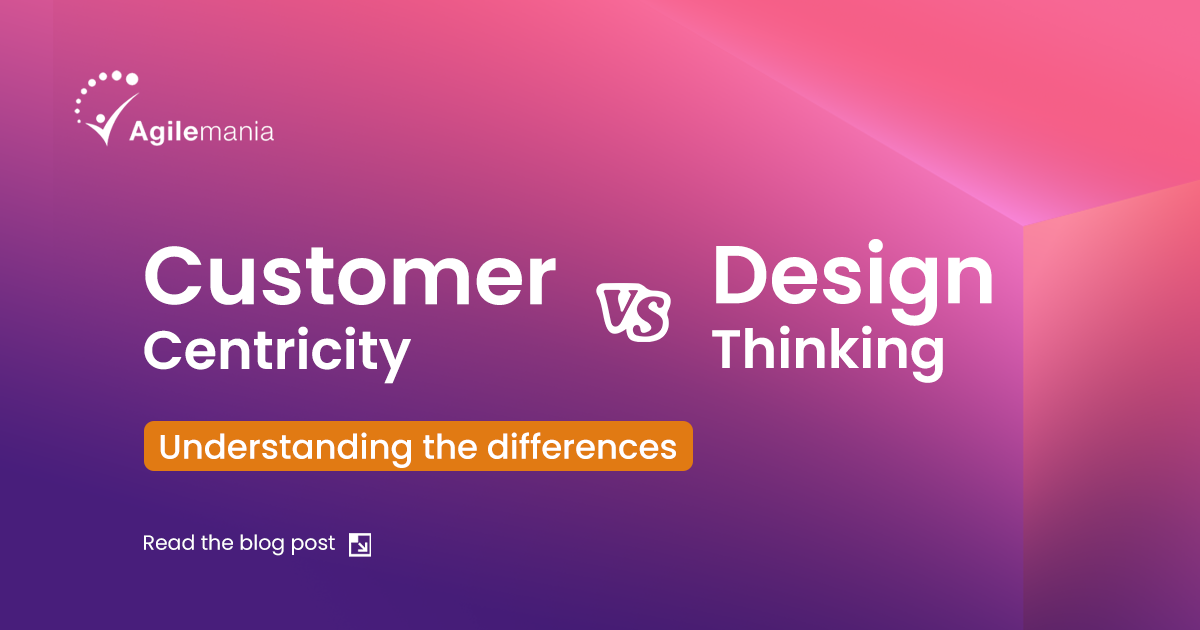
Agilemania
Agilemania, a small group of passionate Lean-Agile-DevOps consultants and trainers, is the most tru... Read more
![]() Get Your AI-Enabled Scrum Master Certification for Just ₹2,500 (Save 75%)!
Get Your AI-Enabled Scrum Master Certification for Just ₹2,500 (Save 75%)!
Scrum.Org
SAFe®
ICAgile
Scrum Alliance
Technical Agility
Kanban
Business Analysis
Project Management
AI-Enabled
Agilemania Academy
Scrum.Org
SAFe®
ICAgile
Scrum Alliance
Technical Agility
Kanban
Business Analysis
Project Management
AI-Enabled

Agilemania
Agilemania, a small group of passionate Lean-Agile-DevOps consultants and trainers, is the most tru... Read more

To deliver great customer experiences, two major philosophies stand out. They are customer-centricity and design thinking. Despite their similarities, these two mindsets are fundamentally different.
Some organizations swear by customer-centricity, while others fully embrace design thinking. This has led to a philosophical divide, with each camp passionately advocating for their preferred approach.
On one side of the debate, you have the customer-centric companies. These businesses live and breathe the customer philosophy, with every decision and process geared towards enhancing customer value and satisfaction.
On the other hand, there are design thinking advocates. These organizations view product and service development through the lens of human-centered design, focusing on empathy, ideation, prototyping, and iterative testing.
The question that often arises is: which approach stands supreme?
Is it better to be customer-centric or to adopt design thinking principles?
However, the most successful companies have realized that this debate is not a matter of choosing one.
Instead, they've found a way to harmoniously blend these two philosophies, creating a powerful synergy that drives innovation and customer delight.
In this blog, we'll examine how leading businesses leverage both customer-centricity and design thinking to stay ahead of the competition, deeply exploring both concepts and exploring the nuances of each.
Customer centricity is all about putting the customer at the absolute center of everything the company does. It means obsessively studying customer needs, behaviors, and pain points through research, data, and feedback. Every decision, process, and action is then oriented around addressing those customer needs in the best way possible. The whole organization is focused on designing the ideal experience tailored for their customers.
Design thinking takes a more hands-on, experimental approach. Companies practicing design thinking dive deep to empathize with how customers use and experience their products or services day-to-day.
They observe customers, identify missing needs, and then go through repeated cycles of brainstorming ideas, building quick prototypes, and getting those prototypes in front of customers to try out and provide feedback. It's an iterative, learning-based process for continuous innovation centered on the customer.

Customer centricity and design thinking are two approaches that organizations use to create products and services that meet customer needs effectively. While they share similarities, they also have distinct characteristics:
A. Customer Centricity: It revolves around putting the customer's needs and preferences at the forefront of decision-making. It involves gathering insights into customer behavior, preferences, and pain points to tailor offerings accordingly.
B. Design Thinking: Design thinking is a problem-solving approach that emphasizes empathy and creativity. It focuses on understanding user needs deeply, generating innovative solutions, and iterating rapidly to address challenges effectively.
A. Customer Centricity: The methodology of customer centricity often involves collecting customer feedback through surveys, interviews, and market research. Organizations use this data to inform product development, marketing strategies, and customer service initiatives.
B. Design Thinking: Design thinking follows a structured process that typically includes stages like empathizing with users, defining the problem, ideating solutions, prototyping, and testing. It encourages cross-functional collaboration and iterative experimentation.
A. Customer Centricity: Customer centricity applies across various business functions, including product development, marketing, sales, and customer support. It informs strategic decision-making and helps organizations build long-term relationships with customers.
B. Design Thinking: Design thinking originated in the realm of product design but has since been adopted in various fields. It can be used to tackle diverse challenges, such as process optimization, service design, and organizational change.
A. Customer Centricity: The ultimate goal of customer centricity is to enhance customer satisfaction, loyalty, and retention. By aligning products and services with customer preferences, organizations can drive revenue growth and profitability.
B. Design Thinking: Design thinking aims to generate innovative solutions that effectively address user needs. It encourages organizations to embrace experimentation and iteration to create products and experiences that delight customers.
A. Customer Centricity: XYZ Inc. adopts a customer-centric approach by conducting extensive market research and gathering feedback from existing and potential customers. They analyze customer preferences, pain points, and behavior to tailor their smartphone features and functionalities accordingly.
For instance, they may prioritize improving battery life based on customer complaints about short battery longevity or introduce a new camera feature in response to high demand from photography enthusiasts.
XYZ Inc. focuses on enhancing customer satisfaction and loyalty by aligning its product offerings with customer needs.
B. Design Thinking: XYZ Inc. applies design thinking principles to innovate and create user-centered smartphones.
They start by empathizing with their target users and understanding their lifestyles, preferences, and challenges.
Through brainstorming sessions and creativity, they generate creative ideas for smartphone designs and features that address specific user needs.
Prototyping and iterative testing allow them to gather user feedback and refine their designs accordingly.
For example, they may prototype multiple versions of a smartphone interface and test them with users to identify the most intuitive design.
XYZ Inc. emphasizes human-centered design throughout smartphone development, aiming to deliver products that delight and engage users.
In conclusion, while customer-centricity and design thinking are distinct approaches, they share a common goal: enhancing the customer experience. By blending the methodologies of both philosophies, businesses can leverage the strengths of each to drive innovation and customer delight. Ultimately, the key lies in understanding the nuances of both approaches and applying them synergistically to stay ahead in today's competitive landscape.
Transform your approach to Product Development and start creating Products that truly matter to your users. Join us for an unforgettable learning experience!
Contact Us
Industries such as retail, hospitality, and healthcare benefit greatly by prioritizing customer experiences.
Common challenges include overcoming fixed mindsets, navigating ambiguity, and ensuring interdisciplinary collaboration.
Both approaches contribute to long-term success by placing the customer at the center of decision-making, fostering innovation, and creating sustainable competitive advantages.
Industries like technology, product design, and education leverage design thinking to create innovative solutions.
Agilemania, a small group of passionate Lean-Agile-DevOps consultants and trainers, is the most trusted brand for digital transformations in South and South-East Asia.
WhatsApp Us
We will get back to you soon!
For a detailed enquiry, please write to us at connect@agilemania.com

